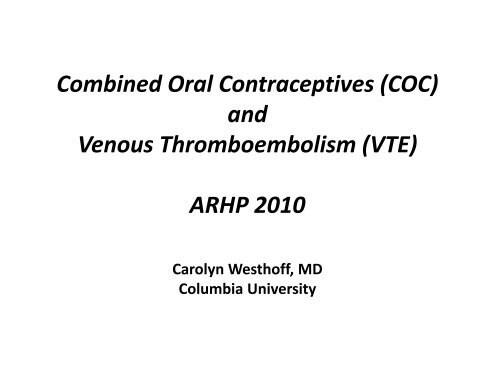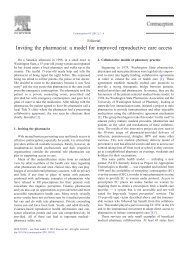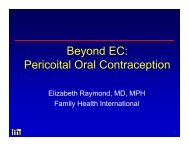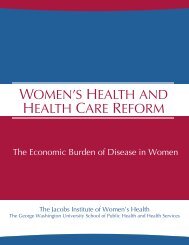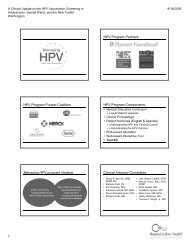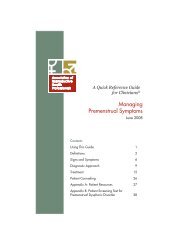Combined Oral Contraceptives (COC) and Venous ...
Combined Oral Contraceptives (COC) and Venous ...
Combined Oral Contraceptives (COC) and Venous ...
You also want an ePaper? Increase the reach of your titles
YUMPU automatically turns print PDFs into web optimized ePapers that Google loves.
<strong>Combined</strong> <strong>Oral</strong> <strong>Contraceptives</strong> (<strong>COC</strong>)<br />
<strong>and</strong><br />
<strong>Venous</strong> Thromboembolism (VTE)<br />
ARHP 2010<br />
Carolyn Westhoff, MD<br />
Columbia University
Disclosures<br />
• Dr. Westhoff consults for :<br />
– Bayer*, Merck*, <strong>and</strong> Duramed<br />
– * sponsors of relevant phase IV studies<br />
– All produce contraceptives to be discussed in this<br />
talk<br />
– Reid RL, Westhoff CL, Mansour D, et al. <strong>Oral</strong><br />
<strong>Contraceptives</strong> <strong>and</strong> <strong>Venous</strong> Thromboembolism.<br />
Consensus opinion from an international<br />
workshop held in Berlin, German in Dec. 2009.<br />
J Fam Pl <strong>and</strong> Repro Hlth Care;2010;36:117‐122.
Learning Objectives<br />
• Underst<strong>and</strong> the risk factors for VTE<br />
• Characterize the association between CHC <strong>and</strong><br />
VTE risk factors<br />
• Describe what we learned about CHC use <strong>and</strong><br />
VTE risk until 2000.<br />
• Discuss what we have learned about CHC use<br />
<strong>and</strong> VTE risk in the last decade
PubMed Search of OC <strong>and</strong><br />
Thromboembolism<br />
http://www.ncbi.nlm.nih.gov/sites/entrez Accessed 9/3/2010
Pathophysiology of VTE: (DVT <strong>and</strong> PE)<br />
Deep Vein Thrombosis (DVT)<br />
� Thrombi in deep veins of<br />
extremities or pelvis<br />
� Often presents as pain, swelling,<br />
in one leg<br />
� May lead to pulmonary embolism<br />
(PE), which has much greater<br />
mortality<br />
MD Consult: Hodgson J et al. Deep Vein Thrombosis. Elsevier Inc. 2007 <strong>and</strong> MD Consult: Thompson A,<br />
et al. Pulmonary Embolism. Elsevier Inc. 2007
VTE background<br />
• Incidence ~ 14 per 10,000 person‐years<br />
• Incidence increases with age<br />
• After one VTE, increased risk of recurrence, <strong>and</strong> long‐<br />
term venous impairment<br />
• Main contributing factors are ‐Stasis of blood flow, ‐<br />
Endothelial damage, <strong>and</strong> ‐ Hypercoagulability<br />
• Doppler is a painless diagnostic test now in wide use,<br />
contributing to higher incidence in recent studies.<br />
Schwartz’s Principles of Surgery 9 th edition: Chapter 24. <strong>Venous</strong> <strong>and</strong> Lymphatic Disease.<br />
Current Diagnosis <strong>and</strong> Treatment: Surgery, 13 th edition: Chapter 35 Veins <strong>and</strong> Lymphatics.
• Increasing age<br />
Risk Factors for VTE<br />
• Increasing weight (obesity)<br />
• Family or personal history of VTE<br />
• Genetic mutations affecting coagulation<br />
• Immobilization or surgery<br />
• Long‐haul travel<br />
• Estrogen containing contraceptives & HRT<br />
Martinelli I. Seminars in Thrombosis <strong>and</strong> Hemostasis. 2006;32 (7): 709-715
European Active Surveillance Study (EURAS):<br />
Increasing Impact of Age <strong>and</strong> BMI on the VTE Risk in <strong>COC</strong> Users<br />
• Risk estimates based on 115 VTEs in 116,708 women‐years of exposure<br />
Dinger JC, et al. Contraception. 2007;75(5):344-354
EE increases<br />
Fibrinogen,<br />
Factors V, VII, VIII,<br />
X, vWF<br />
Activation<br />
Coagulation Fibrinolysis<br />
Antithrombin III<br />
Protein C<br />
Protein S<br />
Activated Protein C<br />
Inhibition<br />
Plasminogen<br />
α2 Antiplasmin<br />
PAI-1<br />
Adapted from Comprehensive Gynecology, 5 th ed. Katz (editor)
OC <strong>and</strong> VTE – 1960’s‐70’s<br />
• 1960 –FDA approval of Enovid<br />
• 1961 –Pulmonary embolism report, Lancet<br />
• 1966 –FDA task force on side effects<br />
• 1969 ‐ The Doctor’s Case against the Pill<br />
• 1970 –Senate hearings about pill safety<br />
• 1970 –FDA m<strong>and</strong>ates package inserts –the<br />
first ever for a pharmaceutical product
The Doctors’ Case Against the Pill<br />
By Barbara Seaman<br />
First published, 1969<br />
25th Anniversary edition, July 1995<br />
"The Nelson Pill Hearings"<br />
In 1970, Gaylord Anton Nelson, a<br />
Democratic Senator from Wisconsin,<br />
called for Congressional hearings on<br />
the safety of combined oral<br />
contraceptive pills.
OC’s <strong>and</strong> VTE – 1980’s<br />
• Larger studies with improved methods starting<br />
to report results. RR range 3‐11.<br />
• Study critiques emerging<br />
• Pertinent factors: Current use rather than<br />
past use. Effect of estrogen dose still unclear.<br />
Duration of use does not matter (sic).<br />
Realini & Goldzieher, AJOG, 1985; Vessey BMJ, 1986
OC’s <strong>and</strong> VTE – 1990’s<br />
• Gerstmann <strong>and</strong> colleagues<br />
– 230,000 women 15‐44 from 1980‐86<br />
EE dose Rate of VTE/10,000 WY<br />
50 μg 10.0<br />
– Data consistent with earlier studies associating the<br />
dose of EE to the risk of VTE; background rate of<br />
0.8/10,000 WY<br />
<strong>Oral</strong> contraceptive estrogen dose <strong>and</strong> the risk of deep venous thromboembolic<br />
disease. AJE 1991.
OC <strong>and</strong> VTE‐ 1990’s<br />
• WHO publication in the Lancet in 1995 was a<br />
case‐control study suggesting that women<br />
using OC formulations with the progestins<br />
desogestrel <strong>and</strong> gestodene had a 1.5‐2.5<br />
higher risk of VTE compared to users of<br />
levonorgestrel preparations with
1990’s Pill Scare<br />
Documented increase in abortion rates<br />
in UK, Norway, other countries<br />
No decrease in VTE among young<br />
women.
1990’s in summary<br />
• Importance of EE dose established<br />
• First studies to compare individual pill br<strong>and</strong>s<br />
• RR with OC use about 2‐3<br />
• RR with pregnancy about 6<br />
• Vigorous critiques of study methodology<br />
• New covariates (eg, Factor V)<br />
• NEW underst<strong>and</strong>ing of role of duration of use
Dinger et al Contraception 2007<br />
Duration of Use Impacts VTE Risk<br />
VTE Incidence vs. Duration of Use
2000’s<br />
• Do non‐oral routes of CHC delivery <strong>and</strong> new<br />
formulations decrease risk of VTE?<br />
• Fatal PE reported in teenaged patch user<br />
• PK shows patch has more EE than pill <strong>and</strong> ring<br />
• RR of VTE with patch compared to OCs,<br />
range 1.1 –2.2.<br />
• FDA label change –“this product exposes<br />
women to higher levels of estrogen than most<br />
birth control pills.”<br />
vdHeuvel 2005; Cole 2007; Jick 2006,2007,2010
FDA m<strong>and</strong>ated post‐approval<br />
surveillance studies ‐ 1.<br />
Prospective cohorts with active surveillance:<br />
Large enough to assess differences in risk between<br />
preparations.<br />
Lifetime history of <strong>COC</strong> use<br />
Complete documentation of relevant risk factors<br />
Documentation & blinded adjudication of all VTEs<br />
Validation of all patient‐reported outcomes with<br />
attending physician
FDA m<strong>and</strong>ated post‐approval<br />
surveillance studies –2.<br />
• Prospective or Retrospective cohort studies:<br />
• Use electronic databases<br />
• Potential to be nimble<br />
• In some, can compensate for lack of<br />
confounder information w nested case‐control<br />
<strong>and</strong> propensity scores.
Newest studies<br />
• EURAS, Dinger, 2007<br />
• Ingenix, Seeger 2007<br />
• MEGA(case‐control), v. Hylckama Vlieg, 2009<br />
• Danish National study, Lidegard, 2009<br />
• Consensus statement, Reid, 2010<br />
• INAS, underway<br />
• Nuvaring cohort, underway
Dinger JC, et al. Contraception. 2007;75(5):344-354<br />
EURAS Study Design
EURAS: Distribution of VTEs<br />
Dinger JC, et al. Contraception. 2007;75(5):344-354
EURAS: Preferential Prescribing of Yasmin to Women with<br />
Risk Factors for VTE<br />
Dinger JC, et al. Contraception. 2007;75(5):344-354
EURAS: VTE Incidence <strong>and</strong> Hazard<br />
Dinger JC, et al. Contraception. 2007;75(5):344-354<br />
Ratio
EURAS: Duration of Use Impact on<br />
Adapted from Dinger et al Contraception 75 (2007) 344–354<br />
VTE Risk<br />
VTE Incidence vs. Duration of Use
Seeger JD, et al. Obstet Gynecol. 2007;110(3):587-593<br />
I n g e n i x : S t u d y D e s i g n
Ingenix: Methodological<br />
Considerations<br />
Electronically captured provider, facility, <strong>and</strong><br />
pharmacy claims from US insurance plans<br />
Matching of Yasmin to two‐fold larger group of<br />
other <strong>COC</strong> users (using propensity scores)<br />
Claims‐based outcomes confirmed via<br />
abstraction of relevant medical records<br />
Seeger JD, et al. Obstet Gynecol. 2007;110(3):587-593
Seeger JD, et al. Obstet Gynecol. 2007;110(3):587-593<br />
Ingenix: Incidence of VTE was Similar Between<br />
Yasmin <strong>and</strong> Other <strong>COC</strong> Cohorts
Ingenix: Yasmin Users Do Not Have a Higher Risk<br />
of VTE Compared to Other <strong>COC</strong> Users<br />
Incidence Rate Ratio –Yasmin vs Other <strong>COC</strong> (95% CI)<br />
Seeger JD, et al. Obstet Gynecol. 2007;110(3):587-593
VTE Risk for Yasmin: EURAS & Ingenix<br />
Dinger JC, et al. Contraception. 2007;75(5):344-354<br />
Seeger JD, et al. Obstet Gynecol. 2007;110(3):587-593<br />
Yasmin vs Other <strong>COC</strong>s
Lidegaard, O et al. BMJ 2009;339:b2890<br />
Danish National Registry:<br />
Study Design
Danish National Registry:<br />
Risk for VTE for Various Progestogens<br />
For <strong>COC</strong>s containing 30‐40 μg EE <strong>and</strong><br />
adjusted for length of use<br />
Lidegaard, O et al. BMJ 2009;339:b2890
Danish National Registry Study:<br />
Duration of Use Impact on VTE Risk<br />
• Lack of first year effect for LNG only<br />
Adapted from Lidegaard O et al, BMJ 2009;339:b2890: Table 2
Danish study limitations<br />
• No information of OC use prior to 1995, thus<br />
cannot account for exact duration of use.<br />
• No information available regarding<br />
confounders (eg, obesity)<br />
• VTEs in registry database cannot be<br />
confirmed in 31%‐71% of cases.<br />
Reid, 2010; Severensin, 2010
Van Hylckama Vlieg, A. BMJ 2009;339:b2921<br />
MEGA Study Design
MEGA Study:<br />
Risk for VTE for Various Progestogens<br />
Adapted from Van Hylckama Vlieg, A. BMJ 2009;339:b2921: Table 3 – Risk of VTE associated with different types of<br />
progestogens in combined oral contraceptives
MEGA study limitations<br />
• C/C study designed to evaluate environmental<br />
<strong>and</strong> genetic factors.<br />
• This is a post‐hoc substudy.<br />
• Controls were partners of male cases.<br />
• Duration of use information incomplete.<br />
• In product comparisons, cases are few <strong>and</strong><br />
thus confidence intervals are wide.
FDA conclusions on 4 studies:<br />
additions to the Yasmin label<br />
• 2 prospective cohort studies showed a<br />
comparable risk of VTE in Yasmin users to<br />
other OC users….<br />
• 2 other studies suggested that the risk of VTE<br />
in Yasmin users was higher… HOWEVER…<br />
small numbers make the risk estimates<br />
unreliable, … <strong>and</strong> estimates of duration of use<br />
may NOT BE RELIABLE<br />
www.accessdata.fda.gov/drugsatfda_docs/label/2010/021098s017lbl.pdf
Putting the VTE Risk into Context<br />
Dinger JC, et al. Contraception. 2007;75(5):344-354
What’s next?<br />
• Cohort studies in progress:<br />
– US/Euro cohort of Yaz <strong>and</strong> Yasmin users (INAS)<br />
– Cohort of Nuvaring users<br />
– No phase IV cohort of patch users.<br />
• FDA requires “PASS” for all new products.<br />
• Will new estrogens lead to different risk?
• extras
VTE Risk<br />
Danish National Registry: Highlighted Results –<br />
Bayer Assessment<br />
� ‘Left-censoring’ changes in observation of VTE risk
Potential Misclassification of Duration of Use<br />
in LNG Users in the Danish Study


